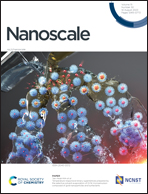Spontaneous sieving of water from ethanol using angstrom-sized nanopores†
Abstract
Ethanol is widely used as a precursor in products ranging from drugs to cosmetics. However, distillation of ethanol from aqueous solution is energy intensive and expensive. Here, we show that angstrom-sized nanopores with precisely controlled pore sizes can spontaneously remove water from ethanol–water mixtures through molecular sieving at room temperature and pressure. For small-diameter nanotubes, water-filling is observed, but ethanol is completely excluded, as evidenced by time-dependent density functional theory (TD-DFT) calculations and spectroscopy measurements. Potential of mean force calculations were performed to determine how the free energy barriers for water and ethanol-filling of the nanotubes change with increasing pore size. Water/ethanol selectivity ratio reaching as high as 6700 is observed with a (6,4) nanotube, which has a pore size of 0.204 nm. This selectivity vanishes as the pore size increases beyond 0.306 nm. These findings provide insights that may help realize energy efficient molecular sieving of ethanol and water.



 Please wait while we load your content...
Please wait while we load your content...